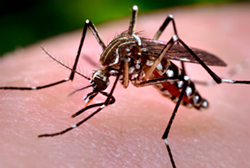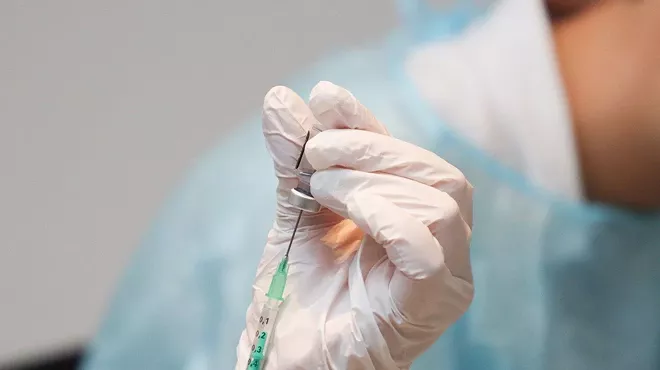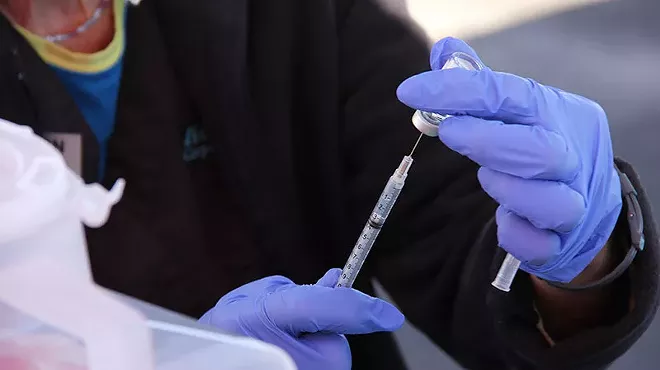Monday, May 11, 2020
How Climate Change Is Contributing to Skyrocketing Rates of Infectious Disease
Page 3 of 3
Once new diseases are let loose in our environment, changing temperatures and precipitation are also changing how those diseases spread — and not for the better. Warming climates increase the range within which a disease can find a home, especially those transmitted by “vectors,” mosquitoes and ticks that carry a pathogen from its primary host to its new victim.A 2008 study in the journal Nature found nearly one-third of emerging infectious diseases over the past 10 years were vector-borne, and that the jumps matched unusual changes in the climate. Especially in cases where insects like infection-bearing mosquitoes are chasing warmer temperatures, the study said, “climate change may drive the emergence of diseases.”
Ticks and mosquitoes now thrive in places they’d never ventured before. As tropical species move northward, they are bringing dangerous pathogens with them. The Zika virus or Chikungunya, a mosquito-spread virus that manifests in intense joint pain, were once unseen in the United States, but both were transmitted locally, not brought home by travelers, in southern Texas and Florida in recent years.
Soon, they’ll be spreading further northward. According to a 2019 study in the journal PLOS Neglected Tropical Diseases, by 2050, disease-carrying mosquitoes will ultimately reach 500 million more people than they do today, including some 55 million more Americans. In 2013, dengue fever — an affliction affecting nearly 400 million people a year, but normally associated with the poorest regions of Africa — was transmitted locally in New York for the first time.
“The long-term risk from dengue may be much higher than COVID,” said Scott Weaver, the director of the Institute for Human Infections and Immunity at the University of Texas Medical Branch in Galveston. “It’s a disease of poor countries, so it doesn’t get the attention it deserves.”
The chain of events that ultimately leads to a pandemic can be long and subtle, steered by shifts in the ecosystem. The 1999 West Nile outbreak in the U.S., for example, came after climate-driven droughts dried up streams and rivers, leaving pools of stagnant water where mosquitoes bred unhindered. It turns out the loss of water also killed off their predators — dragonflies and frogs that depend on large watering holes were gone.
Coronaviruses like COVID-19 aren’t likely to be carried by insects — they don’t leave enough infected virus cells in the blood. But one in five other viruses transmitted from animals to people are vector-borne, said U.C. Davis’ Johnson, meaning it’s only a matter of time before other exotic animal-driven pathogens are driven from the forests of the global tropics to the United States or Canada or Europe because of the warming climate. “Climate is going to shift vulnerability to that,” Johnson said, “and I think some of these regions are not prepared.”
The changing climate won’t just affect how the diseases move about the planet, it will also shape how easily we get sick. According to a 2013 study in the journal PLOS Currents Influenza, warm winters were predictors of the most severe flu seasons in the following year. The brief respite in year one, it turns out, relaxed people’s natural defenses and reduced “herd immunity,” setting conditions for the virus to rage back with a vengeance.
Even harsh swings from hot to cold, or sudden storms — exactly the kinds of climate-induced patterns we’re already seeing — make people more likely to get sick. A study in the journal Environmental Research Letters linked the brutal 2017-18 flu season — which killed 79,000 people — to erratic temperature swings and extreme weather that winter, the same period in which a spate of floods and hurricanes devastated much of the country. If the climate crisis continues on its current trajectory, the authors wrote, respiratory infections like the flu will sharply increase. The chance of a flu epidemic in America’s most populated cities will increase by as much as 50% this century, and flu-related deaths in Europe could also jump by 50%.
“We’re on a very dangerous path right now,” said the University of Texas’ Weaver. Slow action on climate has made dramatic warming and large-scale environmental changes inevitable, he said, “and I think that increases in disease are going to come along with it.”
Twelve months before the first COVID-19 case was diagnosed, a group of epidemiologists working with a U.S. Agency for International Development project called PREDICT, or Pandemic Influenza and other Emerging Threats, was deep in the remote leafy jungle of southern China’s Yunnan province hunting for what it believed to be one of the greatest dangers to civilization: a wellspring of emerging viruses.
A decade of study there had identified a pattern of obscure illnesses affecting remote villagers who used bat guano as fertilizer and sometimes for medicine. Scientists traced dozens of unnamed, emerging viruses to caves inhabited by horseshoe bats. Any one of them might have triggered a global pandemic killing a million people. But luck — and mostly luck alone — had so far kept the viruses from leaping out of those remote communities and into the mainstream population.
The luck is likely to run out, as Yunnan is undergoing enormous change. Quaint subsistence farm plots were overtaken by hastily erected apartment towers and high-speed rail lines, as the province endured dizzying development fueled by decades of Chinese economic expansion. Cities’ footprints swelled, pushing back the forests. More people moved into rural places and the wildlife trade, common to such frontier regions, thrived. With every new person and every felled tree, the bats’ habitat shrank, putting the viruses they carried on a collision course with humanity. By late 2018, epidemiologists there were bracing for what they call “spillover,” or the failure to keep a virus locally contained as it jumped from the bats and villages of Yunnan into the wider world.
In late 2018, the Trump administration, as part of a sweeping effort to bring U.S. programs in China to a halt, abruptly shut down the research — and its efforts to intercept the spread of a new novel coronavirus along with it. “We got a cease and desist,” said Dennis Carroll, who founded the PREDICT program and has been instrumental in global work to address the risks from emerging viruses. By late 2019, USAID had cut the program’s global funding.
USAID did not respond to a detailed list of questions from ProPublica.
The loss is immense. The researchers believed they were on the cusp of a breakthrough, racing to sequence the genes of the coronaviruses they’d extracted from the horseshoe bat and to begin work on vaccines. They’d campaigned for years for policymakers to fully consider what they’d learned about how land development and climate changes were driving the spread of disease, and they thought their research could literally provide governments a map to the hot spots most likely to spawn the next pandemic. They also hoped the genetic material they’d collected could lead to a vaccine not just for one lethal variation of COVID, but perhaps — like a missile defense shield for the biosphere — to address a whole family of viruses at once. (In fact, the gene work they were able to complete was used to test the efficacy of remdesivir, an experimental drug that early clinical trial data shows can help COVID-19 patients.)
Carroll said knowledge of the virus genomes had the potential “to totally transform how we think about future biomedical interventions before there’s an emergence.” His goal was to not just react to a pandemic, but to change the very definition of preparedness.
If PREDICT’s efforts in China had the remote potential to fend off the current COVID pandemic, though, it also offered an opportunity to study how climate and land development were driving disease.
But there has been little appetite for that inquiry among policymakers. PREDICT’s staff and advisers have pushed the U.S. government to consider how welding public health policy with environmental and climate science could help stem the spread of contagions. Climate change was featured in presentations that PREDICT staff made to Congress, according to U.C. Davis’ Johnson, who is now also the director of PREDICT, which received a temporary funding extension this spring. And until 2016, leadership of New York-based EcoHealth Alliance, the research group working under PREDICT funding in Yunnan, was invited several times to the White House to advise on global health policy.
Since Donald Trump was elected, the group hasn’t been invited back.
“It’s falling on deaf ears,” said Peter Daszak, EcoHealth Alliance’s president.
A White House spokesperson did not respond to an emailed request for comment.
What Daszak really wants — in addition to restored funding to continue his work — is the public and leaders to understand that it’s human behavior driving the rise in disease, just as it drives the climate crisis. In China’s forests, he looks past the destruction of trees and asks why they are being cut in the first place, and who is paying the cost. Metals for iPhones and palm oil for processed foods are among the products that come straight out of South Asian and African emerging disease hot spots.
“We turn a blind eye to the fact that our behavior is driving this,” he said. “We get cheap goods through Walmart, and then we pay for it forever through the rise in pandemics. It’s upside down.”












